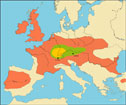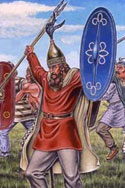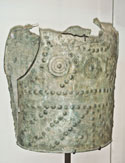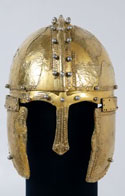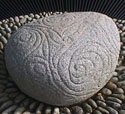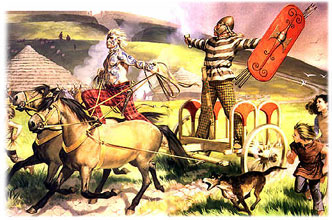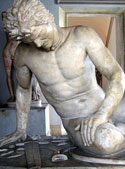| |
The Celtic Nightmare
To the Romans, the people of the East lacked manliness and vigor. This is how they regarded the Egyptians and peoples of the near-East, but the Celts were a different matter. The Romans had more respect for their bravery and ability to fight toe-to-toe. They considered the Gauls to be powerful, although crazy, and felt the Celtic warriors of the Iberian peninsula were cunning and skilled. If fact, the very real threat that their empire would be wiped out by a Celtic invasion was always in the back of their minds, and it almost came true on several occasions. It took the Roman military 500 years before they achieved security from the threat of Celtic warriors pouring through the gates of Rome.
The Celtic Warriors’ Weapons
The Celts used a multiplicity of ancient weapons, which is probably due to their warrior culture. Distance combat weapons were javelins, harpoons, bows and slings. The stones of the slings were usually taken out of rivers, since these were well formed by the current. In addition, one must say that javelins were not necessarily the primary weapons of a warrior; many close-in engagement troops additionally carried thrown weapons. Young warriors fought usually with primitive javelins, slings and bows, while well-crafted pila or harpoon-type javelins were carried by Celtic champions. The Gaesatae, a group of Celtic warriors from the Alps, are said to have used poison on their ranged weapons. In late ancient times, the Picts already used light crossbows. As close-range weapons, spears, two-hand hammers, axes and swords would be used. The swords were initially short swords, but they later became long swords. Celtic swords varied greatly in their quality. There were true masterpieces, but some ancient writers reported swords that, after the first impact of a warrior, bent or became blunt. Some particularly large and well-crafted swords have been found in England that may have been for rituals; however, a military employment is also possible. The Celtic, Celtiberian (that’s a mixed Celtic and Iberian tribe) and Iberian tribes of Hibernia (modern Spain) fashioned a short double-sided sword that was ideal for stabbing. This weapon became the model for the gladius used by the Roman legions. The Celtic spear possessed relatively broad points and were a grand example of this weapon type. Axes, two-hand hammers and two-hand swords (Claymore) were also used, but they were rather rarer weapons. Nevertheless, they belonged to the Celtic arsenal and worked well against well-protected opponents. The force of such a heavy weapon was so great that they could cause fatal injuries through chain-mail armor.
The Celtic Warriors’ Armor
Early La-Tene-era Celtic warriors did not wear armor, although nobles occasionally wore chest plates and chain-mail, a Celtic invention, according to the Romans. Later, leather armor, light bronze breast plates, chain shirts and scale armor were employed, although they were typically beyond the means of common warriors. A special form of armor the Celts developed was called Ceannlann armor. It is a layer of metal scales sewn onto linen, which is, in turn, sewn on to chain armor, creating a very effective multi-layer armor that could cover the entire body. Helmets were also uncommon at first and were mostly worn by nobles. Important forms are the Montefortino helmet and the Coolus helmet, which the Romans imitated for their legionnaires. Another style of helmet came from the Belgae, a Belgian Celtic tribe. Belgian helmets had a typical cone-like form with a long, square and straight plate to protect the neck. Celtic warriors were known to fasten feathers, wings or horse tails to their helmets. Some helmets had real horns or metal horns attached in order to create a fearsome look. Celtic warriors frequently employed shields in all ranges and time periods. Round shields were usually used by light infantrymen or cavalry. Heavy infantrymen carried long shields, usually square, oval or hexagonal. The warrior of a chariot crew probably carried an infantry shield. The Celts often took great pride in the crafting of their shields. They used hide-covered wood with metal ribbing, spines and edges. They were covered with Celtic designs of spirals, circles and animal motifs. One example that survived, dating from 300 BC to 100 AD, called the Battersea Shield, is constructed using sheet bronze and decorated in La Tène art style. It is absolutely stunning; however, it was impractical for combat and was most likely only used for ritual purposes. Celtic shield designs were frequently imitated throughout the classic western world. For clothing, the Celtic warrior usually wore the so-called Braccae wool trousers and a light cloak, although the Romans reported one group of Celts charged into battle completely naked.
Celtic Cavalry
At first, horses were used only in conjunction with chariots. Each chariot consisted of two crew members: a driver and a noble warrior or champion. The ancient writers described the Celtic chariots use as a mixture of cavalry and infantry tactics. The chariot would drive into the battle where the warrior jumps out of the vehicle and fights as an infantry warrior. Once the warrior tired he would jump back on the chariot. The chariots would also drive up and down the battle lines throwing javelins and intimidating opponents with the load noises they made. Caesar describes that the drivers as extremely agile on the chariot, they would even climb forward on the yoke in order to steer the horses better. Celtic chariots used a suspension system that allowed them to operate on rough ground and even on steep hillsides.
Mounted cavalry arose only later, particularly in Britain where chariots were still used in battle much longer than anywhere else in the world. Celtic riders were usually rather light cavalry. They fought by first unleashing a hail of javelins on their opponents, then they followed up by attacking with lances and swords. An exception to this was the nobles who often functioned as heavy cavalry, particuarly in Gual.
Celtic Military Tactics
The normal Celtic sword fighter was probably a heavy infantryman. They typically fought unarmored in a battle line formation. The center piece of Celtic tactics was the mass charge. The wild frontal attack, referred to by the Romans as “the Furor Celtica “, was devastating and could quickly overpower opponents with the sheer power of the impact of the rushing Celtic warriors and their vicious, frenzied attacks. However, the Romans tended to out endure the less well armored and disciplined Celts if they could with stand the initial ferocity of their rush and usually came out on the winning side of prolonged battles. The Celts also fought defensively at times. They could form a deadly and formidable shield wall. Caesar describes a Celtic Phalanx that formed to defend the Helvetia wagons. The Romans set launched their Pila in order to weight down or pin their overlapping shields to one another. The Galatians, who formed a warlike Celtic state in the highlands of central Anatolia in modern Turkey , also used a tight, phalanx like formation. It has been theorized that they developed this technique to deal with the open plains, mounted troops and Greek formations they encountered on their route to Asia Minor. In addition to these open combat methods the Celts also employed Guerilla tactics. They understood well that they could gain an advantage by attacking their opponents from forest or by disturb them with raids and ambushes. This enabled the more lightly armored Celts to take advantage of their speed and knowledge of terrain. At one point during Caesars Gaelic campaign an army of Celts surprised Caesars forces as they were setting up camp. It was only with a great amount of luck, by Caesars own admission, that he and his army were not annihilated.
Celtic Warrior Culture
The Celts were a warrior culture. Fighters were admired like heroes and courage in the battleground was an important virtue. The Celtic elite fighters functioned as models, which should inspire other warriors by their courage.
The Celts cut off the heads of killed enemies and collected them. It was considered a spiritual gesture, which often also appears in other cultures. The head was valued by the Celts as the seat of life, emotions and the soul. He who had captured a head attained the strength of the fallen enemy. Such trophies were bound to their horse or fastened to their belts, a practice that also served to cause fear in their enemies.
One of the main motivations of Celtic warriors was the pursuit of glory and to this end the Celts loved exhibition when in battle. Thus there are legends of a Celtic ruler who drove a silver chariot into battle. Naturally silver is very soft and rather unsuitable for a chariot, but the hostile war bands took to flight at the sight of it. Warriors often painted themselves with woed, a blue die, or used war cries in order to intimidate their enemies. Celtic warriors would also wear horned helmets or helmets topped with horse tails into the battle to intimidate their enemies and make themselves appear taller. A helmet was found crowned with a metal raven. When the wearer ran the metal wings of the raven would flap and strike the helm. This is an allusion on the Celtic mythology in which the death goddess gets the souls of the fallen warriors in shape of a raven.
Celts as Mercenaries
Celts had a long tradition of fighting as mercenaries, Hannibal even had a personal guard of Gaesatae. Celtic mercenaries served as a major force in Hannibal’s powerful field army as well. The Romans took note of this and frequently hired celtic mercenaries during their long military history. In classical times the Galatian warriors were respected by Greek, Pontic and Roman commanders . They frequently hired them as mercenary soldiers, sometimes fighting on both sides in the great battles of the times. For years the Galatian chieftains and their war bands ravaged the western half of Asia Minor, as allies of one or other of the warring princes, without any serious check. Later Celtic groups inherited the mercenary tradition: Scottish highlanders, Welch archers and Irish Kerns often found places in English armies. The French formed from companies of both Celtic swordsmen and cavalry.
|

